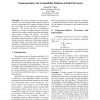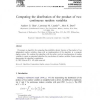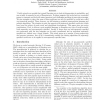111 search results - page 8 / 23 » Examples of Independence for Imprecise Probabilities |
ECAI
2008
Springer
13 years 9 months ago
2008
Springer
This paper describes a novel method for explaining Bayesian network (BN) inference when the network is modeling a population of conditionally independent agents, each of which is m...
AMAI
2002
Springer
13 years 7 months ago
2002
Springer
: We concern ourselves with the situation Here we investigate an extension of the basic concept of in which we use the Dempster-Shafer belief structure to a compatibility relation ...
ICASSP
2011
IEEE
12 years 11 months ago
2011
IEEE
F0 is an acoustic feature that varies largely from one speaker to another. F0 is characterized by a discontinuity in the transition between voiced and unvoiced sounds that present...
CSDA
2004
13 years 7 months ago
2004
We present an algorithm for computing the probability density function of the product of two independent random variables, along with an implementation of the algorithm in a compu...
AI
2000
Springer
13 years 7 months ago
2000
Springer
Credal networks are models that extend Bayesian nets to deal with imprecision in probability, and can actually be regarded as sets of Bayesian nets. Evidence suggests that credal ...



